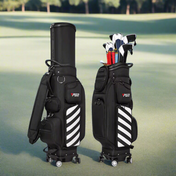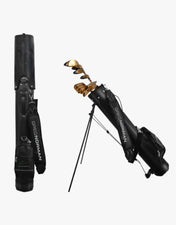Dominant tee-to-green control, flighted approaches on command, and a steadier putter have defined Scottie Scheffler’s run, but equipment choices set the stage for execution.
This breakdown highlights the core gear themes that have fueled his sixth victory of the season, how those choices translate for different swing profiles, and where Indian golfers can find comparable setups through Golfbuy India.
The focus is simple: if the goal is straighter starts and predictable spin, the right head and shaft pairings matter more than hype.
Driver setup and why it works
Scheffler’s driver formula blends a compact, low-spin head with a stable, tip-stiff shaft that keeps face-to-path tight under speed. The result is a heavy, penetrating flight with low curvature that holds line in crosswinds. If “TaylorMade Drive” is the cue, think modern carbon-faced models tuned to 8 to 9 degrees for fast players, then nudged up in loft for mid-speed golfers seeking launch without spin spikes.
For most players in Delhi NCR or Bengaluru, a mid-low spin head paired to a mid-launch shaft in regular or stiff flex will unlock carry without ballooning in warm, thin air.
Fairway wood that actually gets used
The fairway wood in Scheffler’s system is set for reliable off-the-deck launch, not just tee-only bombs. A neutral to slightly open face with a heavier shaft profile stabilises contact and keeps spin consistent from tight fairways. For club golfers, a 15-degree fairway with an adjustable sleeve offers meaningful tuning across seasons.
If the strike's low on the face, consider a slightly higher loft or a model with a lower centre of gravity to maintain ball speed.
Utility iron for gap discipline
Scheffler often relies on a forgiving utility in the 3 or 4 slot to bridge fairway wood and mid-irons. The point is gapping consistency and flight windows, not peak distance. In India, where windy afternoons and firm greens appear often, a hot-faced utility with a mid-flight steel or hybrid shaft can keep approach yardages predictable.
If hybrids hook, test a utility iron; if utilities feel harsh, try a neutral hybrid with a heavier shaft.
Blade irons with tour control
Precision irons like the ones Scheffler favours reward a centred strike and exact launch windows. They fly down without excess spin and produce repeatable distances. For most amateurs, a player's cavity or compact cavity-back is the smarter analogue, delivering the same intent with more forgiveness. Prioritise heads that keep spin tight on slight thin or toe strikes so distances do not jump unpredictably.
Wedges dialled to turf and trajectory
Tour wedge setups hinge on precise sole grinds that match delivery and turf. Scheffler’s approach emphasises consistent spin and strike height, allowing aggressive lines without fearing fliers.
For Indian courses with early-morning dew and variable sand textures, start with a 50 or 52 gap, 56 sand, and 60 lob, then choose bounce by typical turf: higher bounce for soft, dewy mornings, mid bounce for firm fairways and brisk sand. The key is a profile that glides rather than digs when tempo gets quick.
Putter stability that travels under pressure
The move to a higher-stability mallet profile has supported Scheffler’s roll under Sunday pressure. For many amateurs, a mallet with moderate toe-hang balances face control with natural arc. The test is simple: roll ten putts from 10 to 12 feet and track the face start line. If the face wobbles open or closed, try more head stability or a grip change that quiets the hands.
Ball choice that completes the system
A premium urethane ball with consistent cover chemistry keeps spin windows honest from driver to wedges. For fast players, a lower-launch, lower-spin driver profile in the ball can tame tee spin, while still delivering high short-game grab. For moderate speeds, a mid-launch tour ball often raises carry and maintains green-side control. Commit to one model long enough to map full-bag yardages.
How to build a Scheffler-inspired setup
-
Start at the tee: pick a low to mid-low spin head, then loft to ideal launch rather than chasing low numbers.
-
Lock the gap: use a 3 or 4 utility or neutral hybrid to remove the 20 to 30 yard hole between the fairway and the longest iron.
-
Choose forgiving precision: a compact cavity iron gives tour-like windows without punishing slight misses.
-
Fit the wedges to turf: match bounce and sole shapes to the courses played most, then keep loft gaps tight.
-
Stabilise the putter: favour a mallet or stable mid-mallet if the face wanders under pressure.
Where to shop and compare in India
For current driver heads echoing the “TaylorMade Drive” performance profile, plus neutral fairway woods, utilities, and tour-proven wedges, Golfbuy India provides authentic inventory, flexible exchange policies, and guidance on shaft weight and flex that actually fit Indian playing conditions.
When in doubt, ask for a quick launch window check and a wedge grind recommendation based on the primary home course.
Conclusion
Scheffler’s sixth win of the season is a masterclass in matching gear to intent: a penetrating driver flight that holds its line, a fairway and utility that fill gaps cleanly, blades that keep launch windows precise, wedges that trust the strike, and a putter that stays square under heat. Replicate the logic, not just the labels.
Tune the driver to launch, bridge the long-game gaps, pick irons that forgive without spraying spin, and stabilise the putter. Then source with confidence through Golfbuy India to lock in authentic builds and a smart path for future upgrades.




